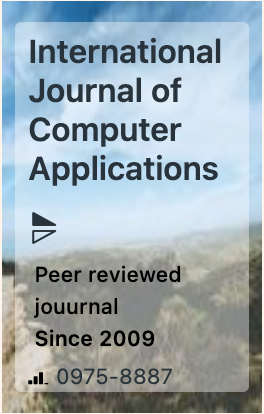The week's pick
Random Articles
Reseach Article
Emerging Trends in Early Lung Cancer Detection via LDCT: A Critical Review
| International Journal of Computer Applications |
| Foundation of Computer Science (FCS), NY, USA |
| Volume 187 - Number 5 |
| Year of Publication: 2025 |
| Authors: Gagan Thakral, Umesh Kumar, Sapna Gambhir |
 10.5120/ijca2025924882
10.5120/ijca2025924882
|
Gagan Thakral, Umesh Kumar, Sapna Gambhir . Emerging Trends in Early Lung Cancer Detection via LDCT: A Critical Review. International Journal of Computer Applications. 187, 5 ( May 2025), 49-61. DOI=10.5120/ijca2025924882
Abstract
Lung cancer remains one of the leading sources of cancer-related mortality throughout the world. The early detection of lung cancer plays a very crucial role in improving a patient’s survival rate. Low-Dose Computed Tomography (LDCT) has emerged as a powerful tool for early lung cancer screening. LDCT scan uses reduced x-ray dose as compared to normal CT scan. LDCT maintains a balance between reduced radiation exposure and high sensitivity. This systematic review follows the PRISMA framework to explore the latest advancements in LDCT-based lung cancer detection. This systematic review also includes artificial intelligence-driven detection support and integration of LDCT scan with multi-modal biomarkers. The review discusses the impact of large-scale screening programs and highlights key challenges such as false positives. The review also provides publicly available datasets. The manuscript provides a systematic review in tabular form with complete details like results, shortcomings, and future scope of the selected papers. The authors also discussed over diagnosis, accessibility, and examined potential solutions to enhance screening efficacy. Additionally, we analyze emerging trends in AI-powered image analysis and the role of deep learning in improving detection accuracy. The study also provides insights about the explain ability in lung cancer detection. LDCT scan has suggestively improved early detection rates and efficiency of the system. Further research is required to improve screening procedures and address its limitations. This systematic review provides understandings of the current state of LDCT for lung cancer detection and future directions for advancing early diagnosis.
References
- S. Xun, D. Li, H. Zhu, M. Chen, J. Wang, J. Li, M. Chen, B. Wu, H. Zhang, X. Chai et al.,“Generative adversarial networks in medical image segmentation: A review,” Computers in Biology and Medicine, vol. 140, p. 105063, 2022.
- G. Thakral and S. Gambhir,“Early detection of lung cancer with low-dose CT scan using artificial intelligence: A comprehensive survey,” SN Computer Science, vol. 5, no. 5, p. 441, 2024.
- N. Borodinov, W.-Y. Tsai, V. V. Korolkov, N. Balke, S. V. Kalinin, and O. S. Ovchinnikova,“Machine learning-based multidomain processing for texture-based image segmentation and analysis,” Applied Physics Letters, vol. 116, no. 4, 2020.
- G. Thakral, S. Gambhir, and N. Aneja,“Proposed methodology for early detection of lung cancer with low-dose CT scan using machine learning,” in 2022 International Conference on Machine Learning, Big Data, Cloud and Parallel Computing (COM-IT-CON), vol. 1. IEEE, 2022, pp. 662–666.
- R. M. Devarapalli, H. K. Kalluri, and V. Dondeti,“Lung cancer detection of CT lung images,” International Journal of Recent Technology and Engineering, vol. 7, no. 5S4, pp. 413–416, 2019.
- Thakral, Gagan, Umesh Kumar, and Sapna Gambhir,“Robust pre-processing strategies for early lung cancer diagnosis with low-dose CT scans,” in 2025 2nd International Conference on Computational Intelligence, Communication Technology and Networking (CICTN), pp. 305–311. IEEE, 2025.
- G. Thakral, U. Kumar, and S. Gambhir,“Implementation of deep learning-based segmentation technique on LDCT scan images for detection of lung cancer in early stages,” in 2024 International Conference on Computing, Sciences and Communications (ICCSC). IEEE, 2024, pp. 1–6.
- S.Cui, S.Ming, Y.Lin, F.Chen, Q.Shen, H.Li,G. Chen,X. Gong, and H. Wang, “Development and clinical application of deep learning model for lung nodules screening on ctimages,” Scientific reports, vol. 10, no. 1, pp. 1–10, 2020.
- A. A. Alsheikhy, Y. Said, T. Shawly, A. K. Alzahrani, and H. Lahza,“A CAD system for lung cancer detection using hybrid deep learning techniques,” Diagnostics, vol. 13, no. 6, p. 1174, 2023. [Online]. Available: https://doi.org/10.3390/diagnostics13061174
- E. A. Siddiqui, V. Chaurasia, and M. Shandilya,“Detection and classification of lung cancer computed tomography images using a novel improved deep belief network with Gabor filters,” Chemometrics and Intelligent Laboratory Systems, vol. 235, p. 104763, 2023. [Online]. Available: https://doi.org/10.1016/j.chemolab.2023.104763
- A. A. Shah, H. A. M. Malik, A. Muhammad, A. Alourani, and Z. A. Butt,“Deep learning ensemble 2D CNN approach towards the detection of lung cancer,” Scientific Reports, vol. 13, no. 1, p. 2987, 2023. [Online]. Available: https://doi.org/10.1038/s41598-023-29656-z
- S. Ali, S. Asad, Z. Asghar, A. Ali, and D. Kim,“End-to-end 2D convolutional neural network architecture for lung nodule identification and abnormal detection in cloud,” Computers, Materials & Continua, vol. 75, no. 1, pp. 461–475, 2023. [Online]. Available: https://doi.org/10.32604/cmc.2023.035672
- M. G. Lanjewar, K. G. Panchbhai, and P. Charanarur,“Lung cancer detection from CT scans using modified DenseNet with feature selection methods and ML classifiers,” Expert Systems with Applications, vol. 224, p. 119961, 2023. [Online]. Available: https://doi.org/10.1016/j.eswa.2023.119961
- R. Manickavasagam, S. Selvan, and M. Selvan,“CAD system for lung nodule detection using deep learning with CNN,” Medical & Biological Engineering & Computing, vol. 60, no. 1, pp. 221–228, 2022. [Online]. Available: https://doi.org/10.1007/s11517-021-02462-3
- H. Guo, J. Wu, Z. Xie, I. W. K. Tham, L. Zhou, and J. Yan,“Investigation of small lung lesion detection for lung cancer screening in low-dose FDG PET imaging by deep neural networks,” Frontiers in Public Health, vol. 10, p. 1047714, 2022. [Online]. Available: https://doi.org/10.3389/fpubh.2022.1047714
- D. K. Jain, K. M. Lakshmi, K. P. Varma, M. Ramachandran, and S. Bharati,“Lung cancer detection based on kernel PCA-convolution neural network feature extraction and classification by fast deep belief neural network in disease management using multimedia data sources,” Computational Intelligence and Neuroscience, vol. 2022, p. 3149406, 2022. [Online]. Available: https://doi.org/10.1155/2022/3149406
- I. A. Choudhry and A. N. Qureshi,“Detection of lung nodules on X-ray using transfer learning and manual features,” Computers, Materials & Continua, vol. 72, no. 1, pp. 1445–1463, 2022. [Online]. Available: https://doi.org/10.32604/cmc.2022.025208
- Z. Xu, H. Ren, W. Zhou, and Z. Liu,“ISANet: Non-small cell lung cancer classification and detection based on CNN and attention mechanism,” Biomedical Signal Processing and Control, vol. 77, p. 103773, 2022. [Online]. Available: https://doi.org/10.1016/j.bspc.2022.103773
- W. Wang and G. Charkborty,“Automatic prognosis of lung cancer using heterogeneous deep learning models for nodule detection and eliciting its morphological features,” Applied Intelligence, vol. 51, no. 4, pp. 2471–2484, 2021. [Online]. Available: https://doi.org/10.1007/s10489-020-01990-z
- X. Rafael-Palou, A. Aubanell, I. Bonavita, M. Ceresa, G. Piella, V. Ribas et al.,“Re-identification and growth detection of pulmonary nodules without image registration using 3D Siamese neural networks,” Medical Image Analysis, vol. 67, p. 101823, 2021. [Online]. Available: https://doi.org/10.1016/j.media.2020.101823
- W. J. Sori, J. Feng, A. W. Godana, S. Liu, and D. J. Gelmecha,“DFD-Net: Lung cancer detection from denoised CT scan image using deep learning,” Frontiers of Computer Science, vol. 15, no. 2, p. 152701, 2021. [Online]. Available: https://doi.org/10.1007/s11704-020-9050-z
- H. Liz, M. Sánchez-Montañés, A. Tagarro, S. Domínguez-Rodríguez, R. Dagan, and D. Camacho,“Ensembles of convolutional neural network models for pediatric pneumonia diagnosis,” Future Generation Computer Systems, vol. 122, pp. 220–233, 2021. [Online]. Available: https://doi.org/10.1016/j.future.2021.03.001
- A. Elnakib, H. M. Amer, and F. E. Z. Abou-Chadi,“Early lung cancer detection using deep learning optimization,” International Journal of Online and Biomedical Engineering (iJOE), vol. 16, no. 6, pp. 82–96, 2020. [Online]. Available: https://doi.org/10.3991/ijoe.v16i06.13657
- Q. Zhang and X. Kong,“Design of automatic lung nodule detection system based on multi-scene deep learning framework,” IEEE Access, vol. 8, pp. 90380–90389, 2020. [Online]. Available: https://doi.org/10.1109/ACCESS.2020.2993872
- T. Sajja, R. Devarapalli, and H. Kalluri,“Lung cancer detection based on CT scan images by using deep transfer learning,” Traitement du Signal, vol. 36, no. 4, pp. 339–344, 2019. [Online]. Available: https://doi.org/10.18280/ts.360406
- Z. Xiao, N. Du, L. Geng, F. Zhang, J. Wu, and Y. Liu,“Multi-scale heterogeneous 3D CNN for false-positive reduction in pulmonary nodule detection, based on chest CT images,” Applied Sciences, vol. 9, no. 16, p. 3261, 2019. [Online]. Available: https://doi.org/10.3390/app9163261
- H. Eun, D. Kim, C. Jung, and C. Kim,“Single-view 2D CNNs with fully automatic non-nodule categorization for false-positive reduction in pulmonary nodule detection,” Computer Methods and Programs in Biomedicine, vol. 165, pp. 215–224, 2018. [Online]. Available: https://doi.org/10.1016/j.cmpb.2018.08.012.
- H. Jin, Z. Li, R. Tong, and L. Lin,“A deep 3D residual CNN for false-positive reduction in pulmonary nodule detection,” Medical Physics, vol. 45, no. 5, pp. 2097–2107, 2018. [Online]. Available: https://doi.org/10.1002/mp.12846
Index Terms
Keywords

